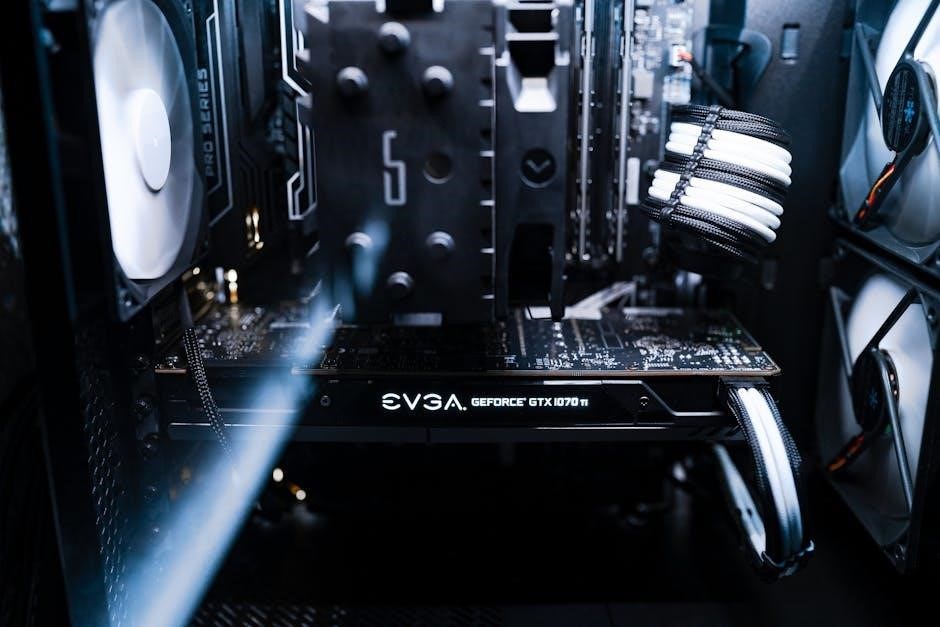Emotional Intelligence (EQ) is the ability to recognize, understand, and manage emotions in oneself and others. Daniel Goleman popularized this concept in his 1995 book, emphasizing its role in personal and professional success. Unlike IQ, EQ focuses on empathy, self-awareness, and social skills, influencing leadership, relationships, and overall well-being. Goleman’s work highlights how developing EQ can enhance decision-making, communication, and emotional resilience, making it a vital skill in today’s fast-paced world.
1.1 Definition and Concept of Emotional Intelligence
Emotional Intelligence (EQ) refers to the ability to recognize, understand, and manage one’s own emotions and those of others. Introduced by Daniel Goleman in his 1995 book, EQ encompasses empathy, self-awareness, and social skills. Unlike Intellectual Intelligence (IQ), EQ focuses on interpersonal and intrapersonal abilities, influencing decision-making, communication, and emotional resilience. Goleman emphasizes that EQ is not fixed and can be developed through practice, making it a crucial skill for personal and professional success. This concept has reshaped modern psychology and leadership, highlighting the importance of emotional awareness in achieving goals and building relationships.
1.2 The Role of Daniel Goleman in Popularizing Emotional Intelligence
Daniel Goleman is renowned for introducing Emotional Intelligence (EQ) to a broad audience through his groundbreaking 1995 book. His work transformed EQ from an academic concept into a widely recognized and essential life skill. Goleman’s ability to simplify complex psychological ideas made EQ accessible to everyone, bridging the gap between academia and everyday life. His influence extends beyond psychology, impacting business, education, and leadership, cementing his role as a pioneer in the field of Emotional Intelligence.
Key Concepts from Daniel Goleman’s Work
Goleman’s work highlights Emotional Intelligence as a vital skill, contrasting it with IQ, and emphasizes its five components: self-awareness, self-regulation, motivation, empathy, and social skills.
2.1 Emotional Intelligence vs. Intellectual Intelligence (IQ)
Emotional Intelligence (EQ) and Intellectual Intelligence (IQ) are distinct yet complementary forms of intelligence. IQ measures cognitive abilities like problem-solving and logical reasoning, while EQ focuses on recognizing, managing, and influencing emotions in oneself and others. Goleman emphasizes that EQ often plays a more significant role in personal and professional success than IQ. Unlike IQ, which is relatively fixed, EQ can be developed and strengthened over time through practice and self-awareness, making it a critical skill for effective leadership and interpersonal relationships.
2.2 The Five Components of Emotional Intelligence
Daniel Goleman identifies five core components of Emotional Intelligence: self-awareness, self-regulation, motivation, empathy, and social skills. Self-awareness involves recognizing one’s emotions and their impact. Self-regulation is managing emotions effectively. Motivation drives goal-oriented behavior beyond external rewards. Empathy is understanding others’ emotions, while social skills enable effective communication and relationship-building. These components collectively enhance personal and professional interactions, fostering emotional resilience and leadership effectiveness.
2;3 The Interplay Between Rational and Emotional Brain
Daniel Goleman explains that the brain operates with two systems: the rational (neocortex) and the emotional (limbic). The rational brain processes logic and facts, while the emotional brain reacts instinctively to stimuli. Emotional hijackings occur when stress triggers the limbic system, overwhelming rational thought. Goleman emphasizes the importance of self-regulation to balance these systems, ensuring emotions inform decisions without controlling them. This interplay is crucial for effective decision-making and emotional well-being, as described in his work on emotional intelligence.

Daniel Goleman’s Book: “Emotional Intelligence”
Daniel Goleman’s 1995 bestseller introduced Emotional Intelligence (EQ) to a broad audience, highlighting its significance over IQ. The book transformed modern psychology and leadership practices, emphasizing empathy, self-awareness, and social skills for personal and professional growth.
3.1 Overview of the 1995 Bestseller
Daniel Goleman’s Emotional Intelligence (1995) revolutionized modern psychology by introducing the concept of EQ as a critical factor in personal and professional success. The book highlights how emotional intelligence, comprising self-awareness, self-regulation, motivation, empathy, and social skills, often surpasses IQ in determining life outcomes. Goleman’s work challenges traditional views of intelligence, emphasizing the importance of understanding and managing emotions to enhance decision-making, relationships, and leadership. This bestseller has become a foundational text, influencing both academic and corporate realms, and remains a cornerstone of emotional intelligence research and application.
3.2 Key Takeaways from the Book
Daniel Goleman’s Emotional Intelligence offers several key insights. It emphasizes that emotional intelligence (EQ) is as crucial as IQ for achieving success. Goleman identifies five components of EQ: self-awareness, self-regulation, motivation, empathy, and social skills. The book highlights how emotional awareness can prevent “emotional hijackings” and improve decision-making. It also underscores the importance of empathy in building strong relationships and leadership effectiveness. Goleman further suggests that EQ can be developed through practice and mindfulness, making it a skill that can be cultivated over time to enhance personal and professional growth.
3.3 The Impact of the Book on Modern Psychology
Daniel Goleman’s Emotional Intelligence revolutionized modern psychology by shifting focus from IQ to EQ. It introduced a framework for understanding emotions’ role in decision-making and behavior, influencing fields like education, leadership, and workplace dynamics. The book’s emphasis on empathy, self-awareness, and social skills reshaped how psychologists and researchers approach human behavior and interpersonal interactions. Goleman’s work also inspired further research into emotional intelligence, making it a cornerstone of modern psychological studies and applications.
Its impact extends beyond academia, shaping business practices and personal development strategies worldwide.

The Components of Emotional Intelligence
Emotional Intelligence comprises five key components: self-awareness, self-regulation, motivation, empathy, and social skills. These elements, as outlined by Daniel Goleman, are essential for understanding and managing emotions effectively in personal and professional realms.
4.1 Self-Awareness: Understanding Your Emotions
Self-awareness is the foundation of Emotional Intelligence, enabling individuals to recognize and understand their emotions in real-time. According to Daniel Goleman, this awareness allows people to acknowledge emotional triggers and patterns, fostering better decision-making and personal growth. By cultivating self-awareness, individuals can gain clarity on their emotional responses, leading to improved self-regulation and overall emotional well-being. This component is crucial for effective leadership and interpersonal relationships, as it promotes authenticity and emotional balance.
4.2 Self-Regulation: Managing Your Emotions
Self-regulation involves effectively managing emotions to respond appropriately to situations. It enables individuals to control impulses, setbacks, and stress, fostering emotional balance. According to Daniel Goleman, this component of Emotional Intelligence helps individuals stay focused and composed, even in challenging circumstances. By mastering self-regulation, people can avoid emotional overreactions and make rational decisions. This skill is essential for building strong relationships and achieving personal and professional goals, as it promotes resilience and adaptability in the face of adversity.
4.3 Motivation: Driving Yourself Toward Goals
Motivation is the internal drive that propels individuals toward achieving their goals. Daniel Goleman highlights that emotionally intelligent people are self-motivated, leveraging their emotions to stay committed and persistent; This component fosters a growth mindset, enabling individuals to embrace challenges and view setbacks as opportunities for growth. By aligning personal values with goals, individuals can maintain focus and enthusiasm, even in the face of obstacles. Cultivating motivation enhances productivity and overall life satisfaction, making it a cornerstone of emotional intelligence.
4.4 Empathy: Understanding Others’ Emotions
Empathy, a cornerstone of emotional intelligence, involves understanding and sharing the feelings of others. Daniel Goleman emphasizes that empathetic individuals can connect deeply with people, fostering trust and cooperation. This skill enables effective communication, conflict resolution, and strong relationships. By tuning into others’ emotions, individuals can respond compassionately and supportively, enhancing teamwork and leadership. Goleman highlights empathy as essential for building rapport and navigating social dynamics successfully, making it a vital component of emotional intelligence in both personal and professional contexts.
4.5 Social Skills: Effective Communication and Relationships
Social skills, as outlined by Daniel Goleman, are the ability to communicate effectively and build strong relationships. This component of emotional intelligence involves active listening, clear expression of thoughts, and adaptability in social interactions. Goleman stresses that individuals with strong social skills can inspire and influence others, fostering collaboration and mutual respect. These skills are crucial for leadership, teamwork, and personal connections, enabling individuals to navigate complex social dynamics with ease and achieve their goals through harmonious relationships.
Emotional Intelligence in Leadership
Emotional Intelligence is vital for effective leadership, enabling leaders to inspire, motivate, and manage emotions within teams. It fosters collaboration, decision-making, and a positive organizational culture.
5.1 The Importance of EQ in Leadership Roles
Emotional Intelligence (EQ) is crucial for leaders as it enhances their ability to inspire, motivate, and manage team emotions effectively. Leaders with high EQ foster strong relationships, drive collaboration, and make informed decisions. They navigate conflicts and stress with resilience, creating a positive work environment. Goleman emphasizes that EQ helps leaders connect with their team’s emotional needs, promoting trust and loyalty. Thus, EQ is essential for sustainable leadership success in both personal and professional realms, making it a cornerstone of effective management.
5.2 Goleman’s Perspective on Leadership and Emotional Intelligence
Daniel Goleman asserts that emotional intelligence is a cornerstone of effective leadership. He argues that leaders with high EQ inspire loyalty, foster collaboration, and drive organizational success. Goleman identifies key components of EQ—self-awareness, empathy, and social skills—as essential for leaders to navigate complex social dynamics. His work emphasizes that emotionally intelligent leaders create resonant cultures, motivating teams to achieve shared goals. Goleman’s perspective underscores EQ as a critical tool for leaders to enhance communication, resolve conflicts, and make informed decisions, ultimately shaping a positive organizational environment.
5.3 Case Studies of Leaders with High Emotional Intelligence
Daniel Goleman highlights leaders like Richard Branson and Howard Schultz as exemplars of high emotional intelligence. These leaders demonstrate empathy, self-awareness, and strong social skills, fostering trust and collaboration within their organizations. Branson’s ability to connect with employees and customers, and Schultz’s focus on employee well-being, illustrate how EQ drives success. Goleman’s case studies reveal that emotionally intelligent leaders create resonant cultures, inspiring loyalty and productivity. Their stories underscore EQ’s transformative impact on leadership effectiveness and organizational outcomes, offering practical lessons for aspiring leaders.

Practical Applications of Emotional Intelligence
Emotional Intelligence enhances workplace collaboration, educational environments, and personal relationships. It aids in conflict resolution, decision-making, and building strong, empathetic connections, fostering overall well-being and success.
6.1 Emotional Intelligence in the Workplace
Daniel Goleman’s work highlights the significance of emotional intelligence (EQ) in professional settings. High EQ fosters effective leadership, collaboration, and communication, reducing workplace conflicts. It enhances decision-making, empathy, and adaptability, creating a supportive environment. Goleman emphasizes that EQ can be developed, benefiting both individuals and organizations by improving productivity and employee satisfaction. By cultivating self-awareness, self-regulation, and social skills, professionals can navigate challenges more effectively, leading to stronger team dynamics and a positive workplace culture.
6.2 Emotional Intelligence in Education
Daniel Goleman underscores the transformative impact of emotional intelligence (EQ) in educational settings. By integrating EQ into curricula, educators can foster self-awareness, empathy, and social skills in students. This approach helps students manage stress, build stronger relationships, and improve academic performance. Goleman advocates for teachers to model EQ, creating supportive learning environments. Schools that prioritize EQ often see increased student engagement, reduced conflicts, and improved emotional well-being, preparing students for future personal and professional success. EQ thus becomes a cornerstone of holistic education, benefiting both individuals and society.
6.3 Emotional Intelligence in Personal Relationships
Daniel Goleman highlights how emotional intelligence (EQ) strengthens personal relationships by enhancing empathy and communication. EQ helps individuals recognize and respond to their partner’s emotions, fostering deeper connections and conflict resolution. By managing their own emotions and being attuned to others, people can build trust, intimacy, and mutual understanding. Goleman emphasizes that high EQ leads to more harmonious and resilient relationships, as individuals navigate challenges with compassion and emotional awareness, ultimately enriching their personal lives and fostering long-term satisfaction.

Developing Emotional Intelligence
Daniel Goleman emphasizes that emotional intelligence can be cultivated through self-awareness, empathy, and mindfulness. Recognizing emotional triggers, practicing self-reflection, and developing social skills are key strategies for growth.
7;1 Strategies for Improving Self-Awareness
Improving self-awareness involves recognizing and understanding your emotions in real-time. Mindfulness practices, such as meditation, help you observe emotions without judgment. Journaling about emotional experiences can deepen insight. Goleman suggests identifying emotional triggers and patterns to better manage reactions. Seeking feedback from others and engaging in self-reflection are also powerful tools. These strategies enhance your ability to understand and regulate emotions, fostering personal growth and stronger relationships. Consistent practice is key to developing this foundational component of emotional intelligence.
7.2 Techniques for Enhancing Empathy and Social Skills
Enhancing empathy and social skills involves practices like active listening and perspective-taking. Goleman emphasizes asking open-ended questions to understand others’ emotions and experiences. Practicing emotional validation helps build trust and connection. Role-playing exercises can improve interpersonal interactions. Additionally, observing nonverbal cues, such as body language and tone, enhances understanding. Regularly engaging in group activities fosters collaboration and empathy. These techniques, when consistently applied, strengthen relationships and improve communication in both personal and professional settings, aligning with Goleman’s principles for emotional intelligence development.
7.3 The Role of Mindfulness in Developing Emotional Intelligence
Mindfulness practices, such as meditation and deep breathing, play a crucial role in enhancing emotional intelligence. By fostering present-moment awareness, mindfulness helps individuals recognize and manage their emotions more effectively. Goleman suggests that regular mindfulness practice improves self-awareness, allowing individuals to respond to situations thoughtfully rather than react impulsively. This increased emotional regulation supports better empathy and social interactions. Mindfulness also enhances focus and clarity, which are essential for maintaining emotional balance and resilience in challenging environments, aligning with Goleman’s strategies for cultivating emotional intelligence.

Criticism and Controversies
Some critics argue that Goleman’s Emotional Intelligence lacks empirical support and oversimplifies complex psychological concepts. Others debate its measurement and question its superiority over IQ in predicting success.
8.1 Criticisms of Emotional Intelligence as a Concept
Some critics argue that Emotional Intelligence (EQ) lacks strong empirical support and oversimplifies complex psychological traits. Others claim it is too broadly defined, making it difficult to measure accurately. Skeptics also point out that EQ’s predictive power for success is overstated, as IQ remains a stronger indicator of cognitive abilities. Additionally, concerns arise about cultural biases in EQ frameworks and the potential for misuse in workplace assessments. Despite its popularity, Emotional Intelligence remains a debated concept within academic and psychological circles.
8.2 Limitations of Goleman’s Theory
Daniel Goleman’s theory of Emotional Intelligence has faced criticism for its lack of scientific rigor and broad definition, which some scholars argue makes it difficult to measure and validate. Critics also question the emphasis on EQ over IQ, suggesting that cognitive abilities remain more critical for certain tasks. Additionally, Goleman’s framework has been accused of overlooking cultural differences and the potential for Emotional Intelligence to be misused in workplace assessments. These limitations highlight the need for further research to refine and strengthen the concept.
8.3 The Debate Over EQ vs. IQ
Daniel Goleman’s work sparked debate about the relative importance of Emotional Intelligence (EQ) versus Intellectual Intelligence (IQ). While IQ measures cognitive abilities, EQ focuses on emotional awareness and social skills. Goleman argues that EQ often predicts success better than IQ, as it influences relationships, decision-making, and emotional resilience. Critics, however, emphasize that IQ remains foundational for problem-solving and logical reasoning. The debate highlights the complementary nature of both intelligences, with EQ enhancing interpersonal effectiveness and IQ driving analytical capabilities, each serving distinct but vital roles in personal and professional success.
The Legacy of Daniel Goleman’s Work
Daniel Goleman’s work revolutionized understanding of Emotional Intelligence, reshaping modern psychology, leadership, and education. His theories transformed workplace dynamics, emphasizing empathy and self-awareness, and inspired further research.
9.1 Influence on Modern Psychology and Business Practices
Daniel Goleman’s work on Emotional Intelligence has profoundly shaped modern psychology and business practices. His theories introduced a paradigm shift, emphasizing the importance of empathy, self-awareness, and social skills over traditional IQ. In psychology, Goleman’s ideas redefined understanding of human behavior and emotional regulation. In business, his concepts transformed leadership development, encouraging a more empathetic and emotionally intelligent approach to management. His influence extends to corporate training, workplace culture, and executive coaching, making Emotional Intelligence a cornerstone of modern professional development and organizational success.
9.2 The Evolution of Emotional Intelligence Research
Research on Emotional Intelligence (EQ) has evolved significantly since Daniel Goleman’s groundbreaking work. Initially focused on individual traits, studies now explore EQ in diverse contexts, such as education, leadership, and mental health. Advances in neuroscience and psychology have deepened understanding of emotional regulation and empathy. Goleman’s framework has inspired interdisciplinary approaches, integrating EQ with fields like sociology and education. His ideas have also sparked debates, driving further investigation into the role of emotions in decision-making and interpersonal dynamics, ensuring EQ remains a dynamic and expanding field of study.
9.3 Goleman’s Later Works and Contributions
Daniel Goleman continued to expand his work on Emotional Intelligence through various books and collaborations. His 1998 book, Working with Emotional Intelligence, explored practical strategies for enhancing EQ in professional settings. Goleman also co-authored Primal Leadership with Annie McKee and Richard Boyatzis in 2002, focusing on leadership and emotional intelligence. Additionally, he collaborated with the Dalai Lama on Healing Emotions, emphasizing emotional well-being. Goleman’s later contributions include exploring ecological intelligence and advocating for the role of educators in fostering EQ, ensuring his ideas remain influential across diverse fields.


































